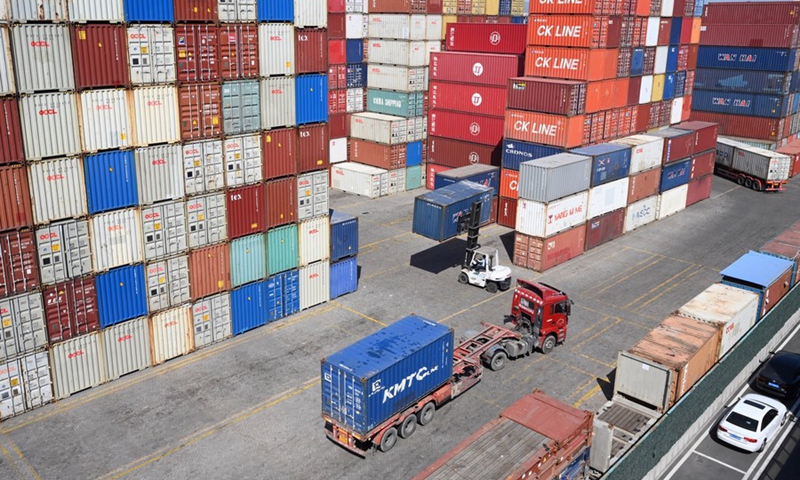
Photo taken on Nov. 10, 2020 shows the Xiamen Area of China (Fujian) Pilot Free Trade Zone in Xiamen, east China's Fujian Province.Photo: Xinhua
China and New Zealand have ratified an upgraded version of their long-standing free trade agreement, which is expected to inject more vitality into the two economies. It marks an important step in implementing the free trade agreement (FTA) upgrade strategy, experts and businesspeople said.
The Chinese Ministry of Commerce (MOFCOM) on Tuesday said that the two countries had completed the domestic approval procedures for the upgraded version, which comes into effect on April 7.
The upgraded FTA will see both countries open their markets for a range of wood and paper products and optimize trade rules such as rules of origin, and remove technical barriers to trade and customs facilitation, the MOFCOM said in a statement.
The upgraded deal will help boost China-New Zealand trade and economic cooperation more extensively and deeply, as it will inject more certainty and vitality into the Asia-Pacific regional economy amid ongoing global geopolitical tensions, Bai Ming, deputy director of the international market research institute at the Chinese Academy of International Trade and Economic Cooperation, told the Global Times on Tuesday.
The upgraded deal also marks an improvement of the quality and efficiency of China-New Zealand free trade relations on the basis of the Regional Comprehensive Economic Partnership (RCEP), the world's largest free trade one, which came into force in January this year.
RCEP includes the 10 members of the Association of Southeast Asian Nations and five major economies in the region -- China, Japan, South Korea, Australia and New Zealand.
On the basis of the RCEP deal, China will further open up services sectors including aviation, education, finance and retirees' insurance to New Zealand, as well as promote trade of timber and paper products. In some cases, the bilateral provisions exceed the level of the RCEP stipulations, experts said.
"New Zealand was one of the earliest countries to ink FTA deals with China, and it has maintained that pioneer positions ever since," Bai noted.
New Zealand wood and paper products will be the primary industries to benefit from the upgraded FTA, Wang Jiazheng, chief representative of the Guangdong Economic and Trade Representative Office in New Zealand (GETRONZ), told the Global Times.
Among the key outcomes of the upgrade is the elimination of tariffs on 12 wood and paper products over a 10-year period. Once fully implemented, that means 99 percent of New Zealand's $4 billion wood and paper export to China will receive tariff-free access.
"We are looking forward to further optimization of rules of origin, reduction of technical barriers, and customs facilitation. We also expect the two sides to jointly create a favorable environment for growing e-commerce, improve transparency and enhance bilateral trade facilitation," Wang said.
Separately, most New Zealand dairy products sent to China are entitled to duty-free access, according to the deal.
"We are encouraged by the progression of the strong economic relationship between the two partners. As the relationship flourished between the two nations, it was with great foresight that both countries saw a need to upgrade the FTA. Over the course of the last decade, we can see that significant economic opportunities have opened up for both countries," Teh-han Chow, CEO of Fonterra Greater China, told the Global Times on Tuesday.
"We envisage that with the upgrade, we will see closer cooperation between the two countries across a number of areas for decades to come. In an era where protectionism pops up from time to time in the world, it is encouraging to see China and New Zealand continue to take leading steps toward freer trade," Chow said.
In 2008, China signed an FTA with New Zealand, the first FTA between China and a developed economy. The two sides announced the conclusion of their three-year negotiations on the upgrade in November 2019. The upgrade comes as New Zealand is competing with other countries including Australia to supply farm goods to China.
"Our trade agenda has very good momentum, with our primary industry exports forecast to hit a record $50 billion this year," said Damien O'Connor, New Zealand's minister of agriculture, and the Ministry of Trade and Export Growth in a statement on Tuesday, adding that goods and services trade between China and New Zealand reached $20.1 billion in the year ended June 2021.
Closer trade relations between China and New Zealand should be a strong driving force for Australia to correct its wrongdoings and restore China-Australia economic and trade relations, Wang from GETRONZ said.
"Since 2020, the Australian government has made frequent attacks on China on a number of major issues concerning China's core interests, which have seriously undermined the mutual trust between the two countries," he said. "The Australian side should make more substantive efforts to bring back China-Australia relations to normalcy."




